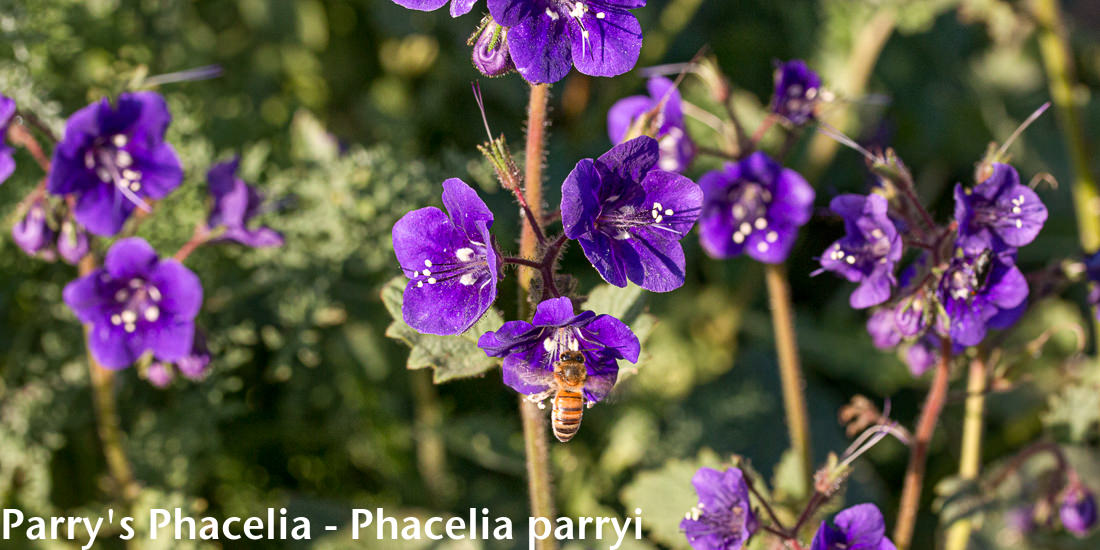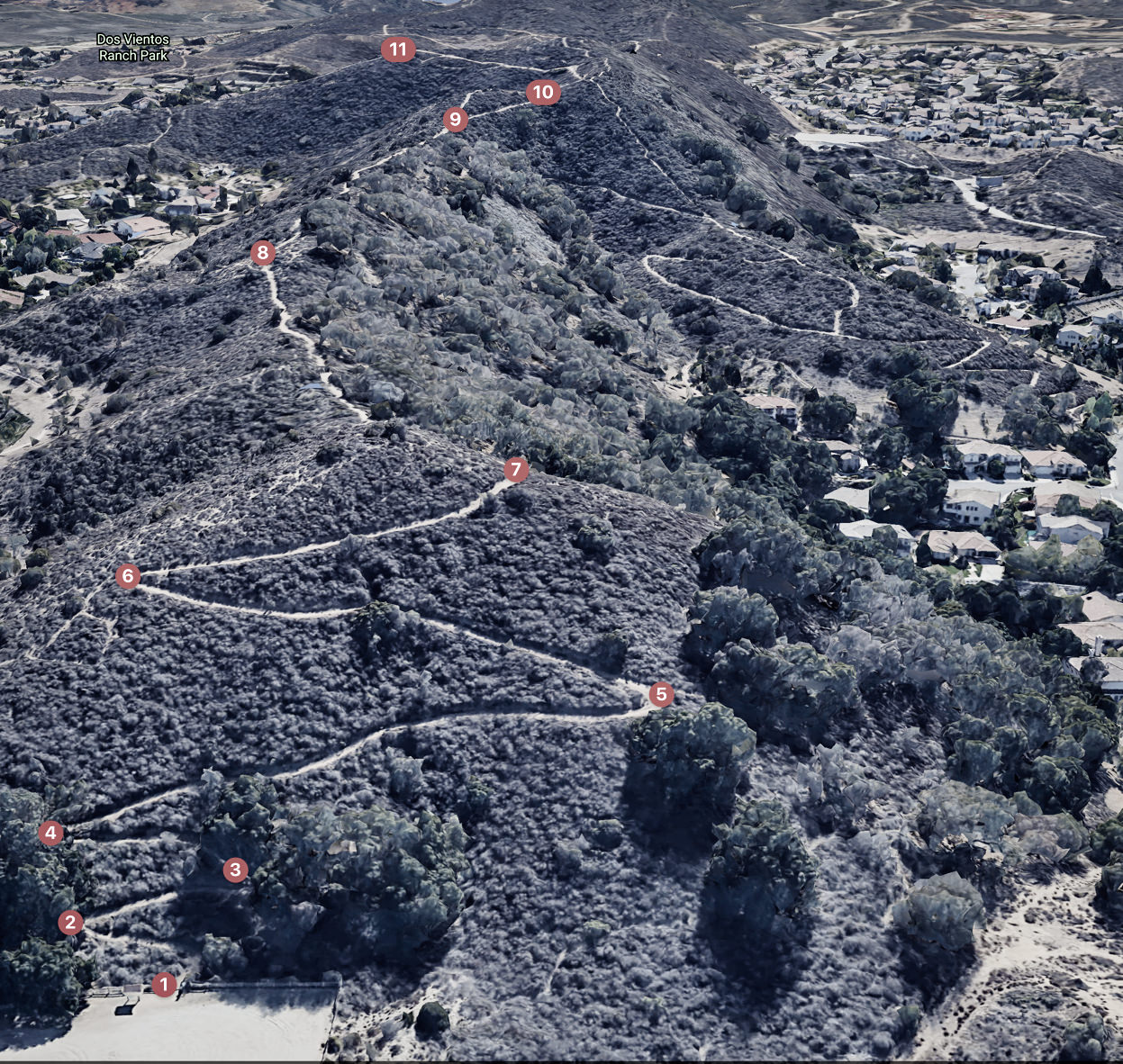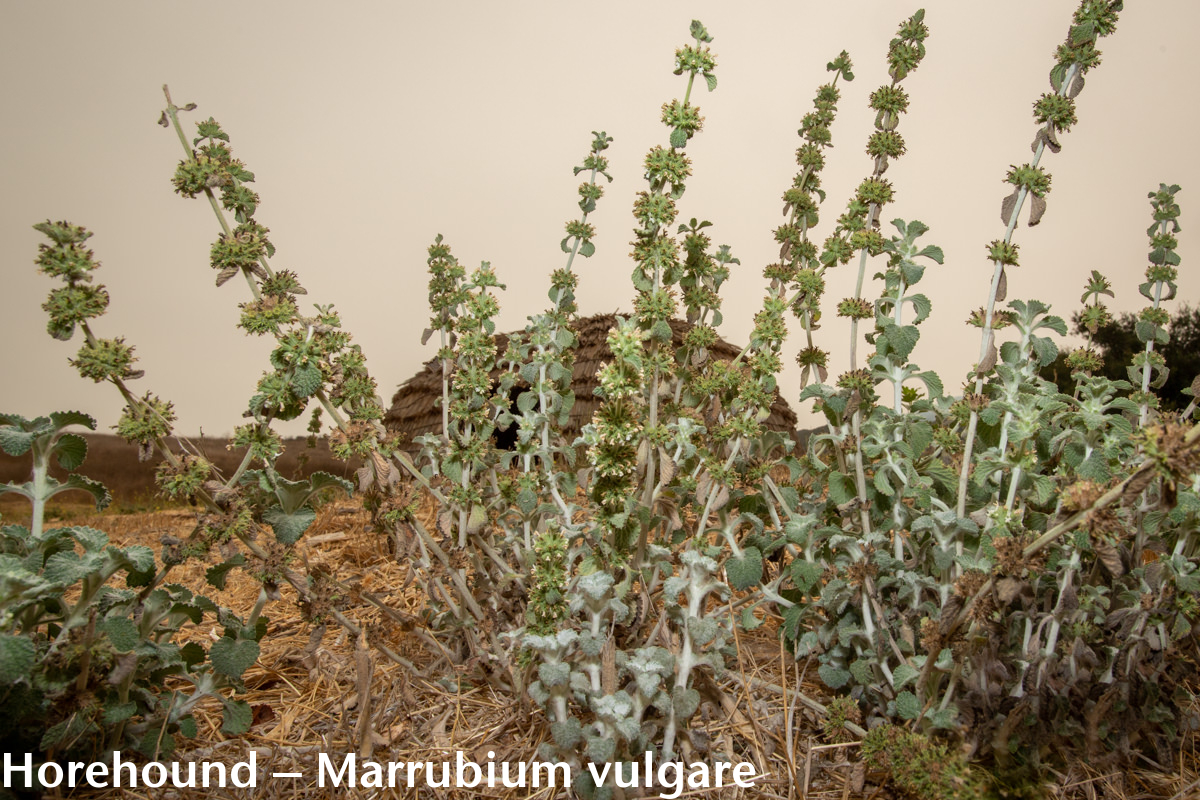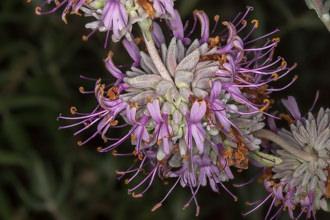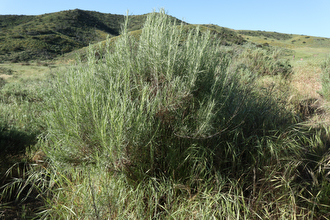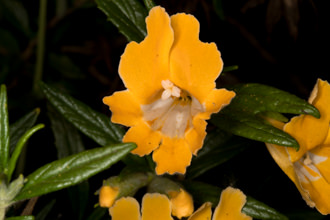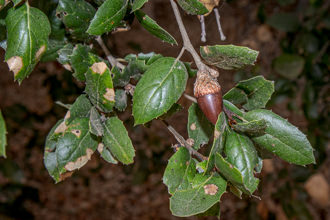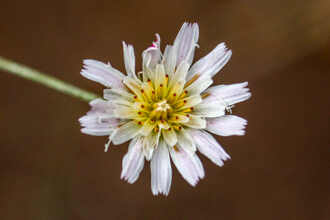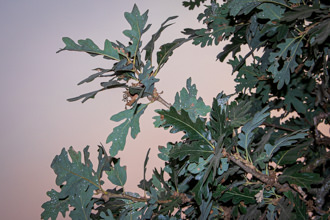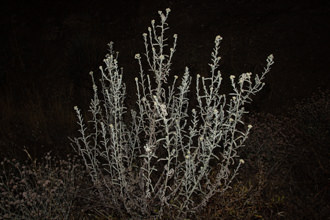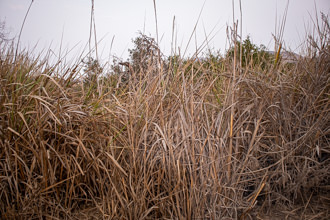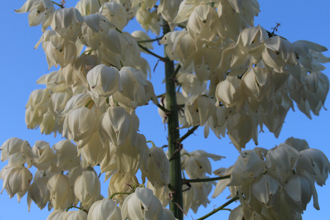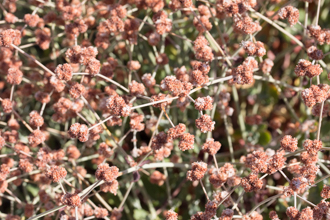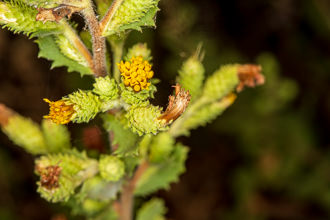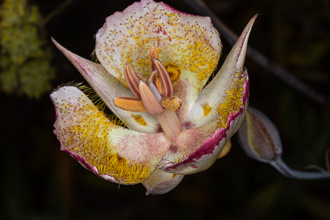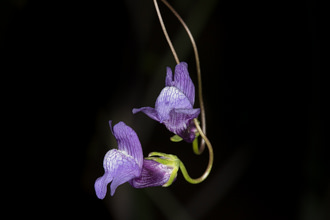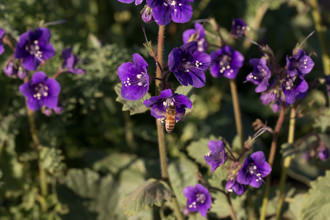Potrero Ridge Trail - Plant Guide
Step over the 18” barrier and you are immediately immersed into wild lands set aside to provide a therapeutic outlet to the nearby residents. You could run, hike or bike this trail hundreds of times and remain blissfully unaware of the various plants that exist here.
Plants reduce erosion and provide a visual element of ‘wildness’ but more importantly feed and provide cover for the wild life that call this area home. Our trail was cut thru the vegetation - such that the lack of vegetation in the four foot wide section of bare earth defines the trail.
Our adventures along the trail tend to compact the soil and prevent most plants from growing back on it. Life seems to find a way though - seeds dispersed into the soil seek opportunities to further their species,
shrubs look to expand their footprint - thus requiring continual maintenance such as the removal of encroaching brush and often invasive species. If you have read this far, this guide will help you identify the many species of plants that you are likely to observe.
This guide will describe the plants in the order that you are likely to encounter them. Please note that many plants are seasonal and will be visible only during the spring. However, shrubs and trees and flowers in bloom from one or more species will always be found. When you set foot, tire or hoof onto this trail
you are entering a world within a world where the denizens have adapted to environmental variables such as amount of sunlight, temperature, seasonal rainfall, soil type, pollinator preferences along with changes implemented by humans. If you do not see something for the first time during your time on the trail you are not paying attention!
Horehound –
Marrubium vulgare
Naturalized. Very common, somewhat evergreen perennial with a preference for disturbed habitats - roadsides, vacant lots, and along trails, because the seed pods become attached to clothing or fur. Summer usually causes the plant to lose most of its leaves. As a member of the Mint family, Horehound shares traits such as square stems, opposite leaves and whorled flowers with other sage plants like Purple Sage and Black Sage. Many sages are aromatic, Horehound is somewhat aromatic at best. Interestingly enough, this plant was/is used to make candy.
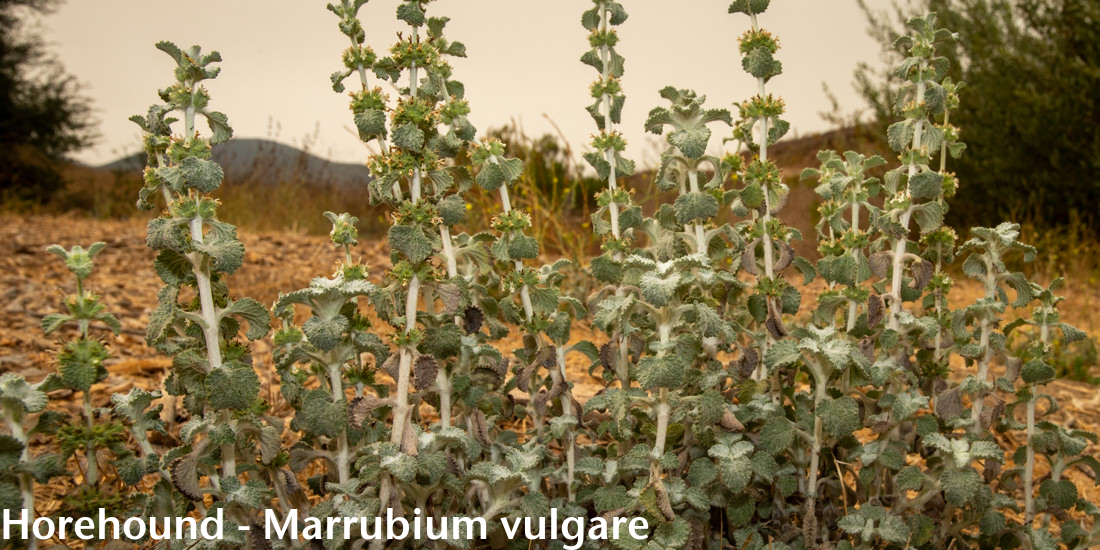
Elderberry -
Sambucus nigra subsp. caerulea
Native, perennial shrub, showy blossoms in late spring become clusters of bluish-purple, edible berries in late summer. Small, creamy-white, 5-petalled flowers in flat-topped bunches can be observed from April to August. The pea-size berries that follow are used in making jams, pies and wine. Many kinds of birds flock to the fruit and bees frequent the flowers. The leaflets have toothed edges and are about 2 inches long, arranged on branches that are opposite and pinnately compound. The base of the plant usually is multi-trunked.
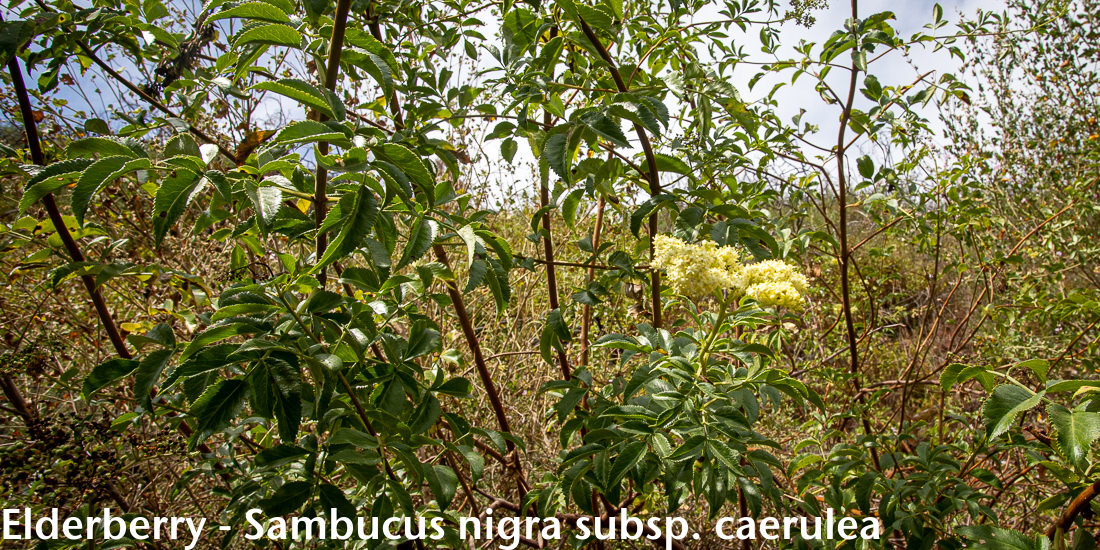
Purple Sage -
Salvia leucophylla
Native, evergreen shrub that grows up to five feet tall and nearly as wide as it is tall. Leaves are a light green in the spring, turning grayish-white as they mature. The leaves can also be described as crenulated (a more precise word for scalloped), fuzzy on the bottom side and are soft like felt. Many branches arch out from the center towards the sky as they reach for the sunlight. The flowers grow in compact whorls on 15 to 20 cm (6 to 8 inches) long inflorescences. If you look at the plant stalks where the flowers are blooming you can observe the stalk transition from wooden twigs to a sort of herbaceous pink gray shaded stalk. The 2.5 cm (1 inch) flowers are pinkish-purple, surrounded in a calyx that is some color between purple and gray.
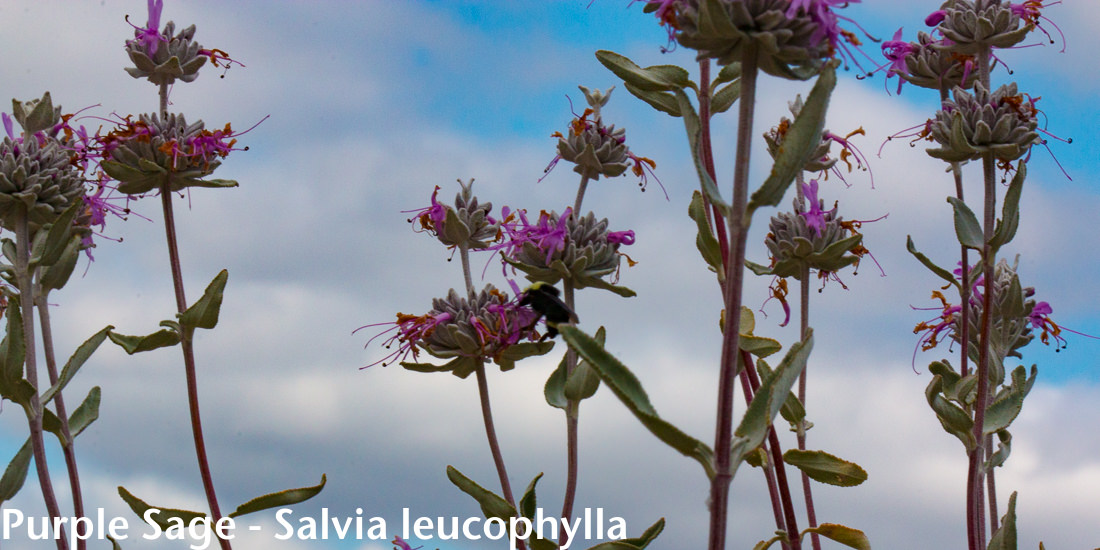
California Sage -
Artemisia californica
Native, evergreen shrub. Common in our mountains. So common, that an environmental community of flora and fauna includes its name - coastal sage scrub and an important member of many chaparral, coastal dune, and dry foothill plant communities. California Sage is not a true sage - the plant is aromatic like many sages but belongs in the family of Asters due to having composite flowers. California Sage AKA California Mugwort, California Sagewort or Coastal Sagebrush in some areas. Rubbing the leaves in your hands removes any doubt regarding the origin of the common name. Ramble through the Sagebrush and you will smell like the "outdoors" - the term 'Cowboy Cologne' comes to mind.

Wild Cucumber -
Marah macrocarpus
Native, perennial, vine. One of the first signs that Spring is just around the corner is when you begin to see the small white fuzzy flowers and the plant's long green vines streaming from the ground and up and over shrubs. Long vines, curled tendrils and small white flowers contrast with the more subdued colors of other plants waiting for their turn to produce flowers. Male flowers arrive first and are followed a few weeks later by female flowers. The showy white male flowers are less than an inch in diameter and appear in groups of up to 20. The pollinated female flowers become large spiny seed pods with a resemblance to certain medieval weapons. Wild Cucumber flowers are considered monoecious: both male and female flowers can be found on the same plant. Male flowers tend to be open clusters, whereas the swollen base distinguishes female flowers. An advantage of being monoecious: Wild Cucumber can easily be self-fertilized. Its leaves are about 4 inches in diameter, and palmately lobed. Large dark seeds are within the pod. The flowers are present from January through June.
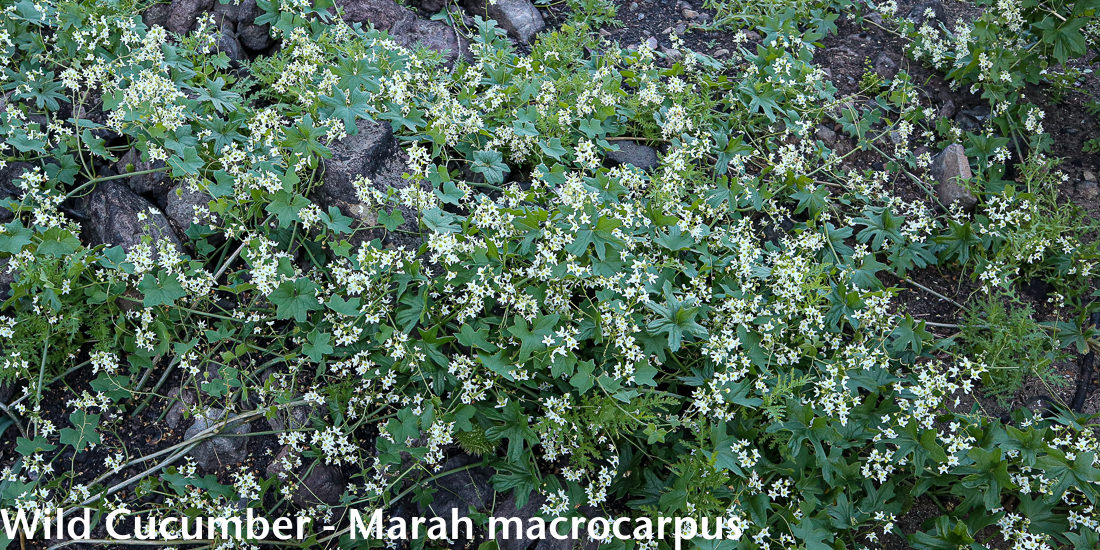
Morning Glory -
Calystegia macrostegia
Native, perennial vine. Bright white cheerful-looking trumpet-shaped blooms and a long summer flowering time. Blooming typically occurs from March to August. It is particularly abundant after a fire. The large mostly- to all-white funnel-shaped flowers grow to 2 inches or so in diameter, sometimes with purple stripes in the folds. The purple is symbolic of a more mature plant. Leaves grow from short stems and are triangular or arrow- or spade-like and up to 2 inches long.
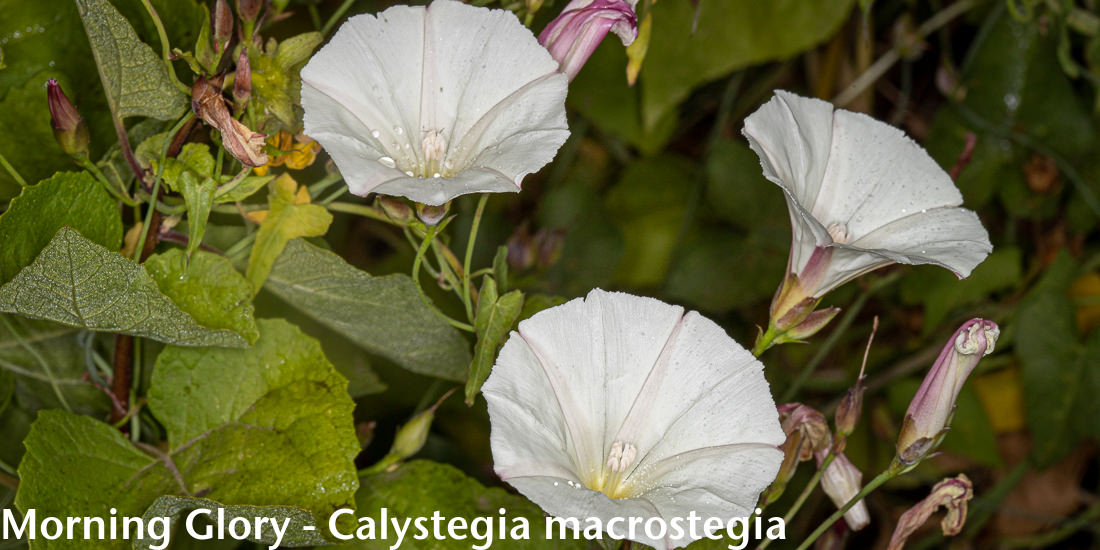
Bush Monkey Flower -
Diplacus longiflorus
Native, perennial, shrub. Commonly known by at least two names, Sticky Monkey flower or Bush Monkey Flower is the orange to yellow flower that brightens our slopes in the late Spring. The botanical name has been changed to reflect recent research. Mimulus aurantiacus is now Diplacus longiflorus. Monkey Flowers have been divided into two groups - based upon where they are found. The Creek and Scarlet Monkey Flowers live in Riparian environments while Bush and Yellow Monkey Flowers along rocky slopes. This plant is sticky, brightly colored and an ideal first flower that is not a Lupine or Poppy for a budding naturalist to learn to identify. Does the flower look like a Monkey face? Not that I can tell. Is is particularly beautiful? Maybe! It is however, ubiquitous along many trails.
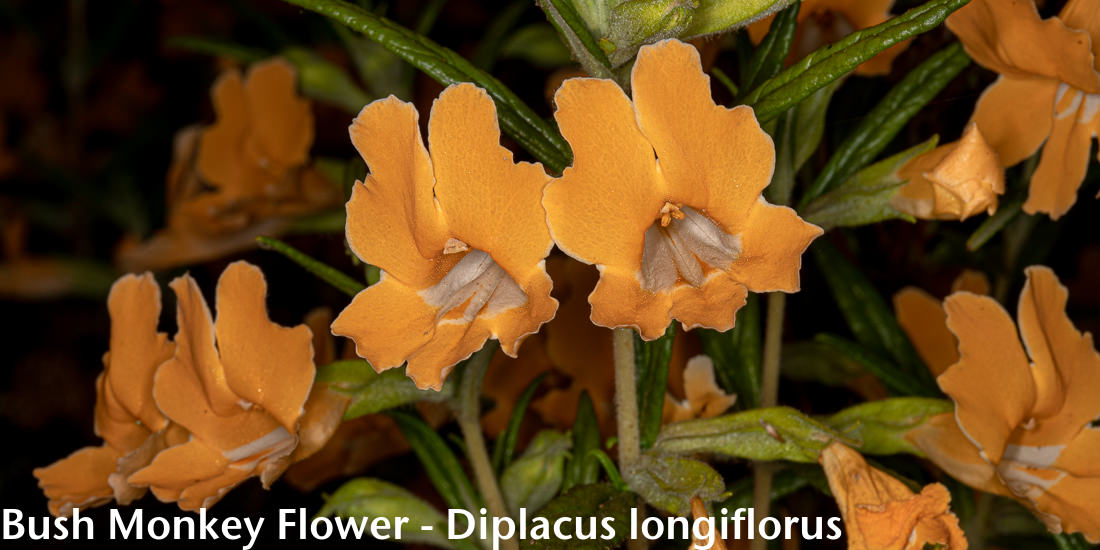
Coast Live Oak -
Quercus agrifolia var. agrifolia
These majestic trees can live three centuries, reach heights of 30 to 75 feet, form crowns that can extend 130 feet across and can be 9 to 12 feet in girth - creating a distinct and charismatic profile in the Santa Monica Mountains. The direction the limbs grow seems unpredictable - sometimes growing downwards, even to the point that they touch the ground. A tap root is initially sent down to secure water and the tree. Eventually, horizontal root branches take over the task of securing water.
Coastal live oaks have tough 'leathery' evergreen leaves that protect against herbivory and are mostly convex (cup-like). This 'cupping' shape is believed to collect dew and mist, which would allow the tree to survive years with limited rainfall. the leaves are dark green, oval, ¾ to 4 inches long and ½ -1 1/2 inches wide - leaf texture and shape are similar to holly. Leaves vary on the same tree - areas with lots of sun are often different than areas with more limited light. Every part of the tree is highly adapted to maximize its ability to gather water, light and nutrients from the environment. Leaves that receive the most sunlight exposure tend to be smaller and thicker, with extra layers of photosynthetic cells to capture sunlight. Where there is less light, leaves tend to be thinner, wider, and flatter, with only one layer of photosynthetic cells. When the tree is young the leaves feel rougher and spinier to discourage animals from eating them.
Young trees have smooth gray bark and as the trees mature, furrows develop in the bark giving the tree a distinctive appearance - kind of like gray hair and wrinkles makes us older folk, look - older.
Native, Tree.
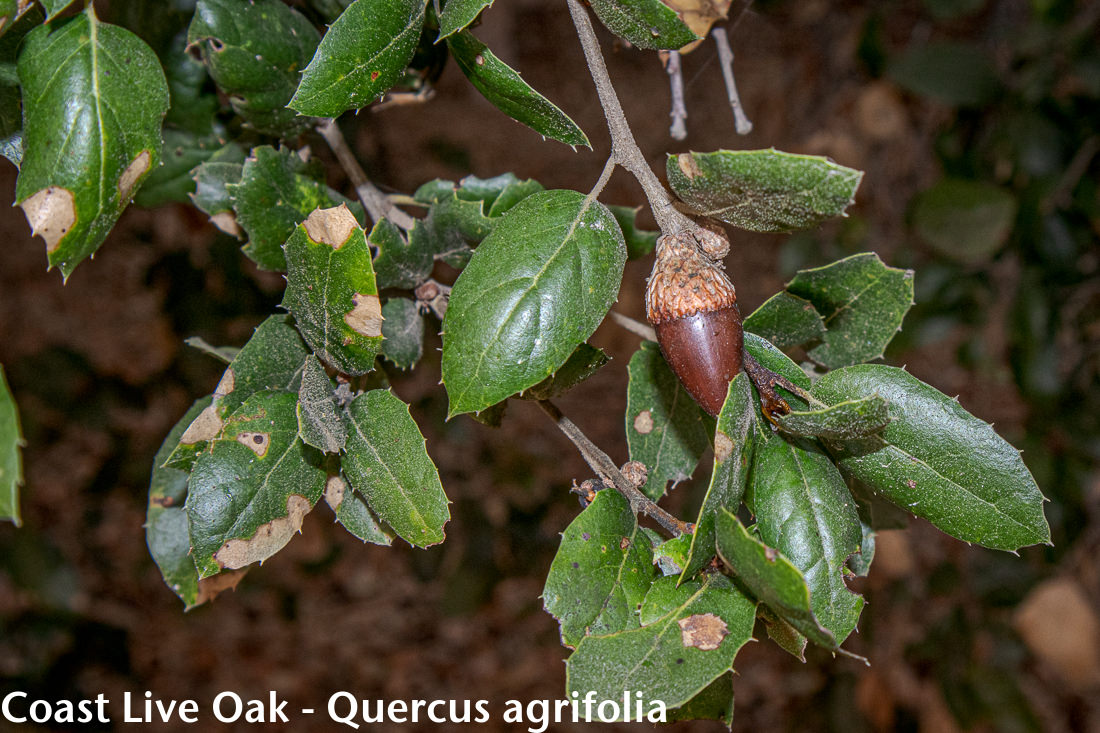
Coyote Brush -
Baccharis pilularis
Native, perennial, shrub. While not particularly stunning in appearance, this plan is appreciated for being one of the few plants that remains green throughout the dry summer and fall months, and it blooms in the fall as well. Coyote Brush produces clusters of cream colored flowers from August through December. Male and female flowers appear on different plants (the Botanical term for this is “Dioecious”), with male flowers being smaller and yellower, while female flowers persist longer and have a more fluffy appearance towards the end of the blooming period. Coyote Brush is categorized as an Aster. Unlike most other Aster flowers there are no ray flowers - only disk flowers. Flowers on this plant are quite small - less than a quarter inch - but are very numerous! In bloom, this normally drab green plant is adorned with thousands of snowy white puffs.
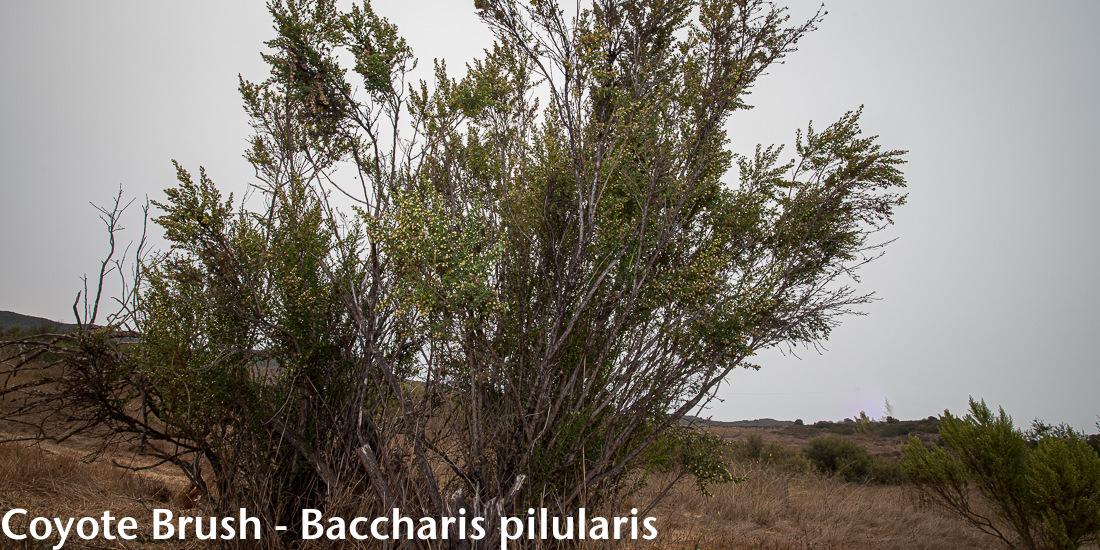
Valley Oak -
Quercus lobata
Considering its size, age, and grandeur, the valley oak has been called "the monarch of California oaks" and can reach heights over 100 feet with roots reaching down 75 feet. The massive (up to seven feet in diameter) trunks are built to endure - they can live up to 600 years. The tree gets its species name, Quercus lobata, from its deeply lobed leaves that are shed in the wintertime. This contrasts with the coast live oak, which keeps its more spiny leaves year-round.
Native, Tree.
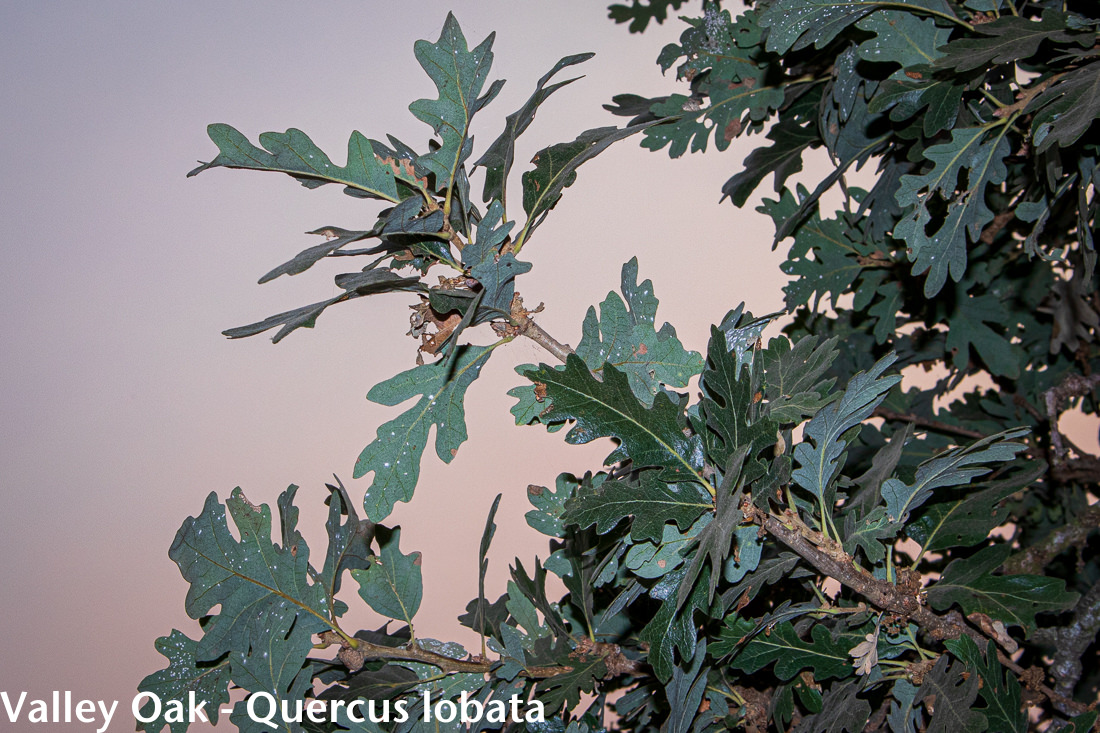
Black Sage -
Salvia mellifera
Native, perennial, shrub. This is the sage plant you are most likely to see along the trails in our local mountains. Considered a keystone species because quite a variety of birds, bees, butterflies, insects and animals depend on this plant for nourishment and habitat. Removing this plant from an area would leave a hole that existing flora could not fill. The color of the plant appears dark during dry years - which may be why it is called Black Sage. Brush up against Black Sage, and you find that this plant transfers its scent you and your clothing.
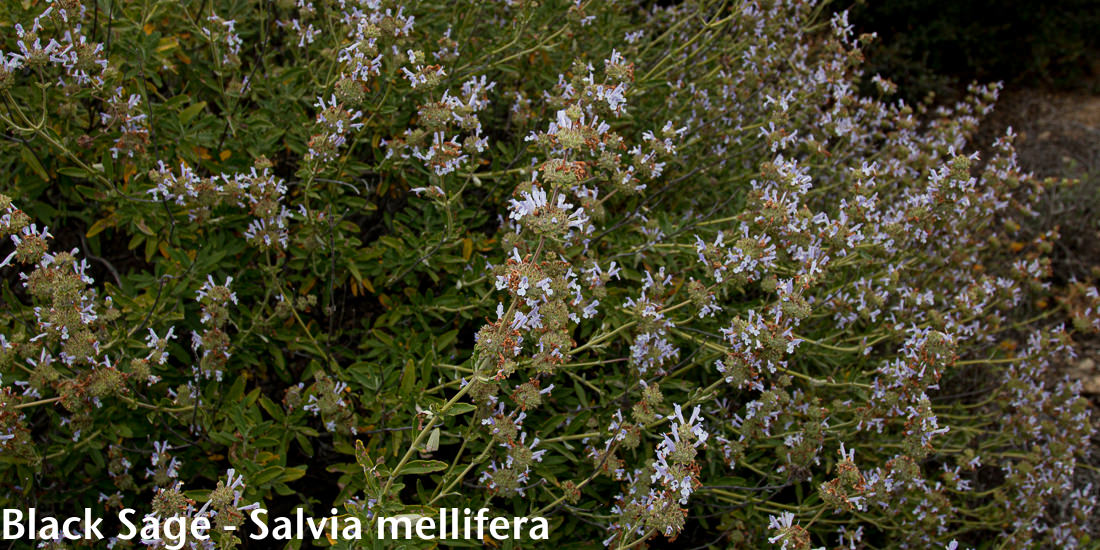
Cliff Aster -
Malacothrix saxatilis
Endemic, perennial, herb. Cliff Aster grows up to six feet high and has narrow, tapering leaves from one to four inches long. Lower leaves usually are coarse-toothed and clustered near the plant's woody base. Upper leaves have smooth margins. Favors disturbed areas, such as habitats along paths and bordering landscaped areas. This plant is endemic (found only in California). Cliff Aster blooms in Summer and all the way through the Winter, long after most other native plants have ceased activity. Just when you think there are no more flowers to see after the Spring bloom your eyes will be drawn to this tiny but gorgeous flower. The flower ranges from about one to two inches in diameter and about three quarters of an inch deep.
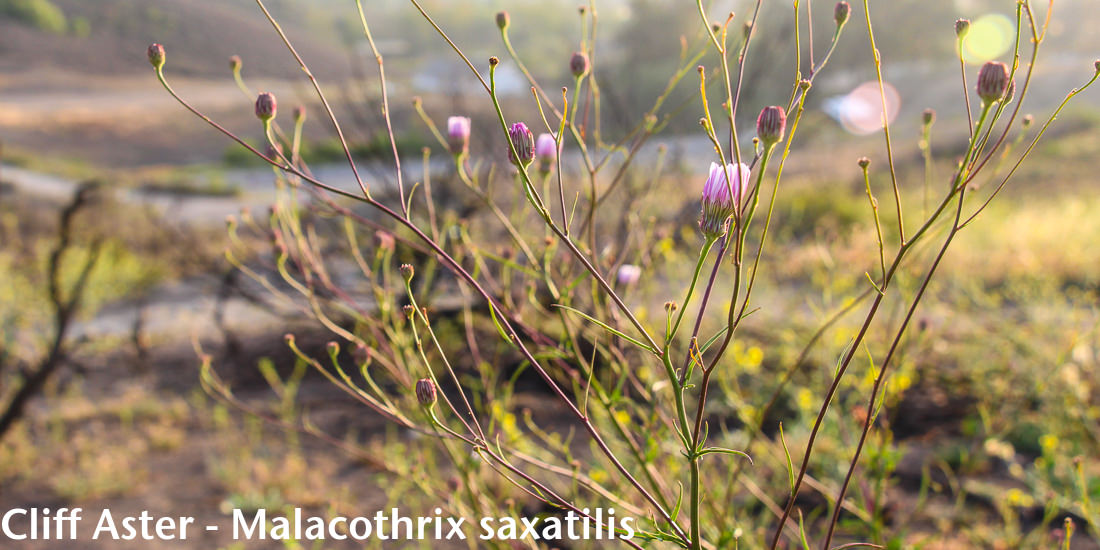
Purple Night Shade -
Solanum xanti
Native, perennial, herb. One of the few plants to be found in bloom early in the year, and commonly blooms from January to May in sage or chaparral habitat. It is an evergreen shrub up to 3 feet high and wide, displaying purple flowers about one inch in diameter. One would think that all Purple Nightshades come in purple, but alas there are some with white petals - not to be confused with White Nightshade aka Douglas' nightshade aka Greenspot nightshade - which has star shaped flowers! If you have ever wondered why Botanist’s prefer Latin names for plants - this is the reason. Local names often vary and from place to place and are often based upon limited observations. California has several species of purple flowers with fused lobes, green spots and elongated yellow anthers that vary by micro adaptations to their preferred environments. To the average person they all look the same. Commonly called names like Purple Nightshade, Blue Witch, Purple Witch, and Parish’s Nightshade - Solanum xanti, Solanum douglasii, Solanum Umbelliferum and Solanum parishii are different plants with different characteristics. Their Latin names reflect keen observations by botanists and a standardized naming process that works in all regions of the world. The more you know the more you need to know!
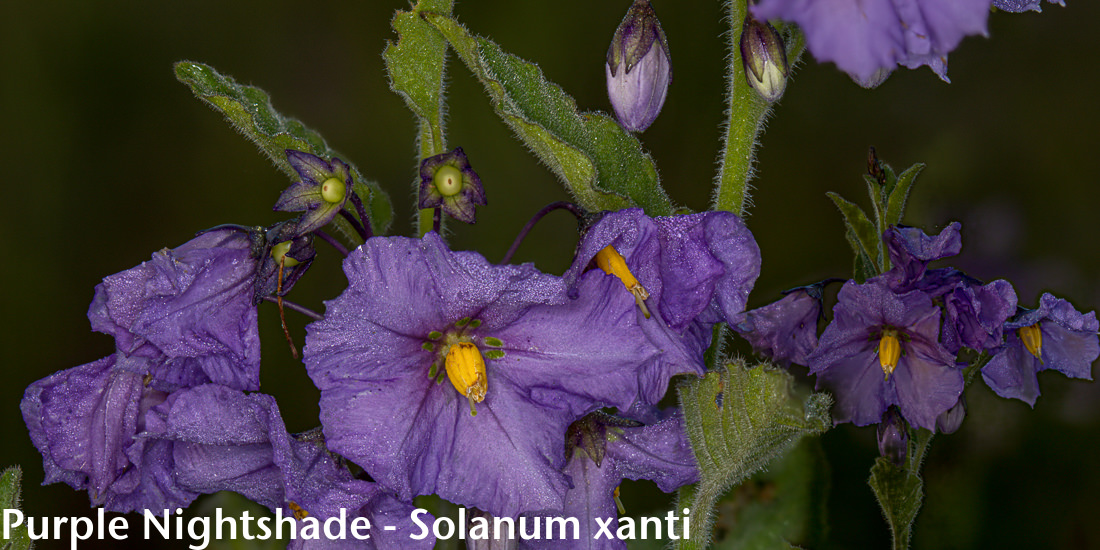
Felt Leaf Everlasting
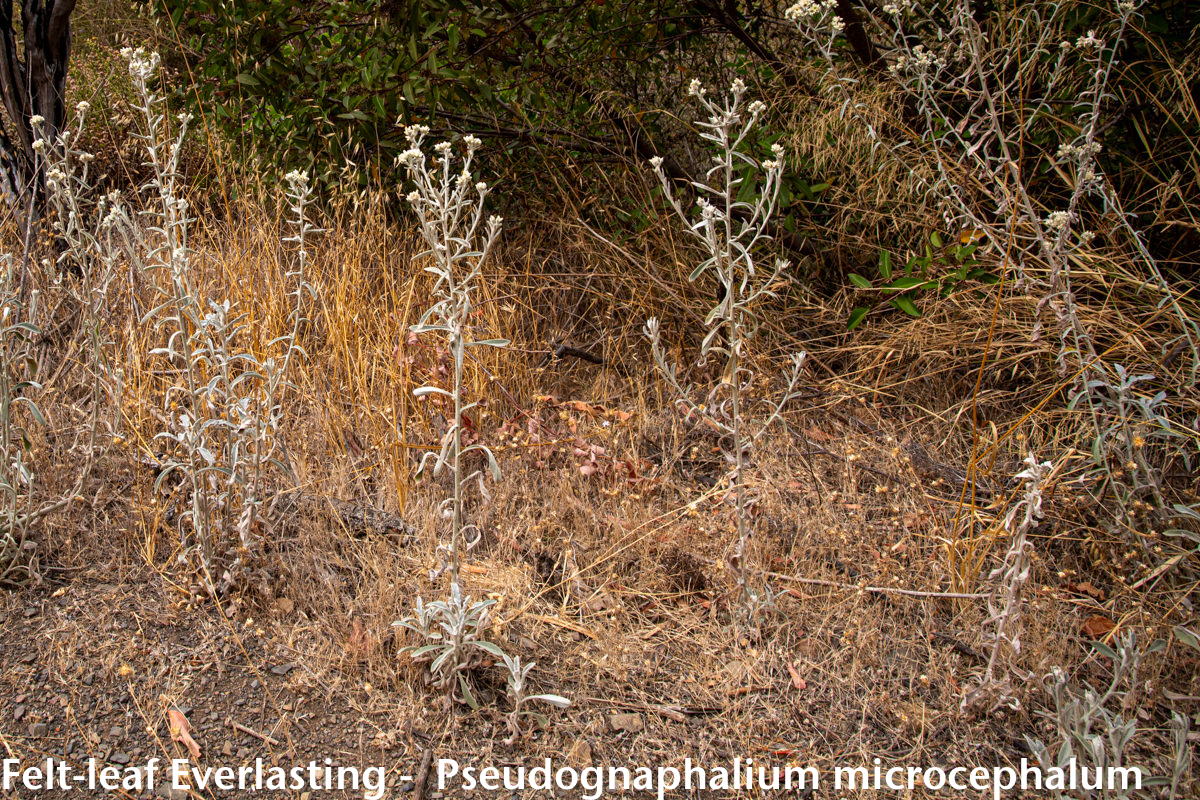
California Peony -
Paeonia californica
Native, perennial, herb. Blooms from January to April. Its flowers have petals the color of red-wine, are about an inch and a half long, and have a heavy-looking, downward-cupped shape. They are quite unusual looking, though not very noticeable due to their ability to blend in with the rest of the plant. I first admired this plant's bushy foliage and leaf structure before the flowers caught my eye. The peony relies on winter rains to spring back from its dormant state that it adopts in summer. Often a clump of hollow stems emerges from the roots but it also may grow more individually. Its flowers grow on singular stalks and have 5 or 6 petals, and as they mature develop prominent seed pods at their center. The flowers never open completely, maintaining a cupped shape.

Giant Wild Rye -
Elymus condensatus
Native, perennial, herb. I love the surprised look on people's faces when I point out this "Giant" grass. Blades big enough to have been used as arrows by native peoples.
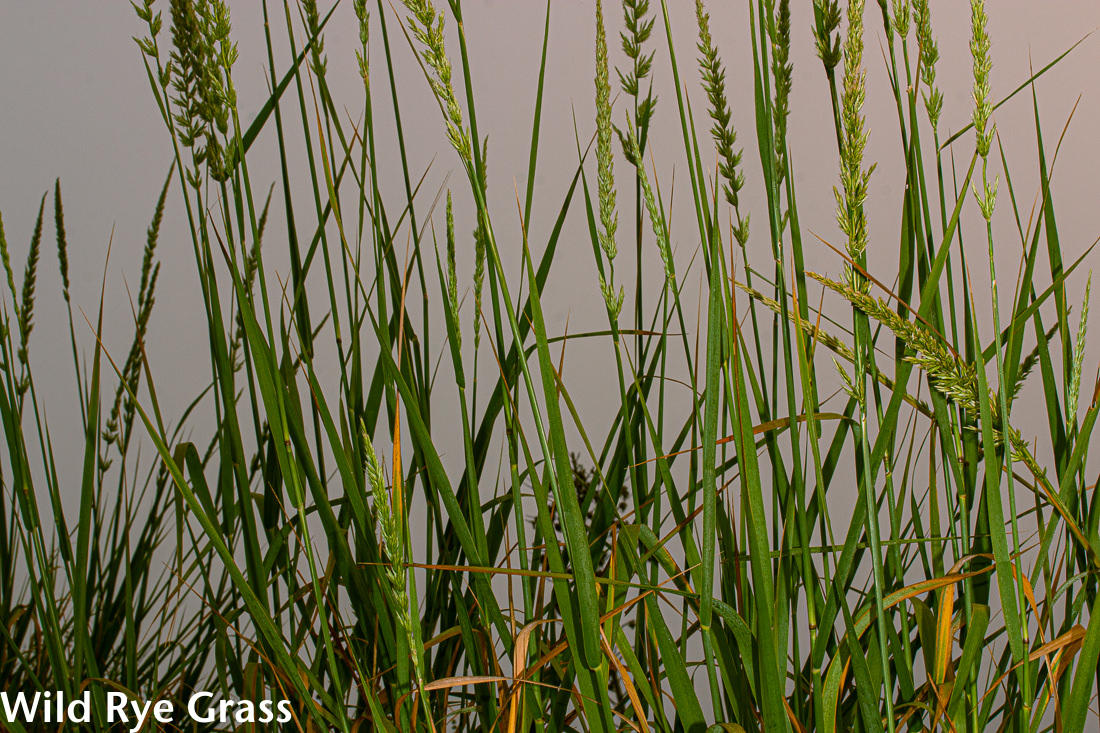
Bee Plant -
Scrophularia californica
Native, perennial, herb. Many plants have beautiful flowers, this plant has flowers that could be considered ‘whimsical’. Numerous tiny red flowers grow from a nearly six foot stalk. The flowers are quite inconspicuous - it’s leaves are far more noticeable.
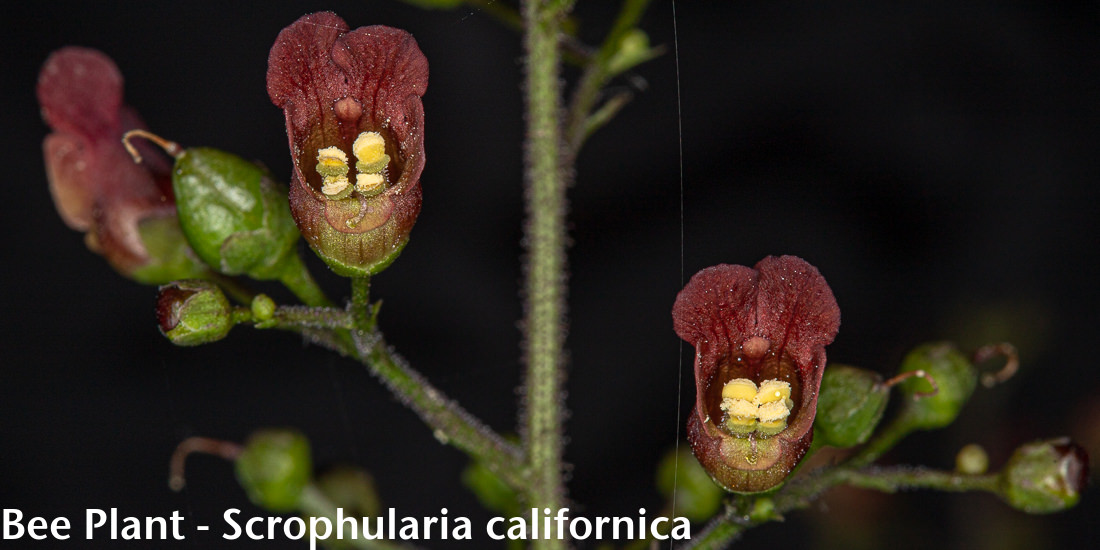
Laurel Sumac -
Malosma laurina
Native, Perennial, shrub/tree. Very ubiquitous in the Santa Monica Mountains, one of the predominant evergreen shrubs populating the hillsides throughout the year. It grows quickly and strong, forming a rounded shape, but may perish from a cold frost. However, after either frost or a fire, it is quick to resprout leaves and stems from its large underground burl. Leaves on this plant are up to 6 inches long, leathery, lanceolate, folded and curved back (kind of like a taco), starting out red then turning to a bright green. Frequently the red color remains in the mature leaf's edges. Stems also start out red, then turn reddish-brown then sometimes gray as the plant matures. Flowering occurs in early summer primarily, with the terminal clusters of small cream-colored flowers quickly giving way to red berries with white seeds. The flower clusters persist on the plant well after the flowers and berries are spent.
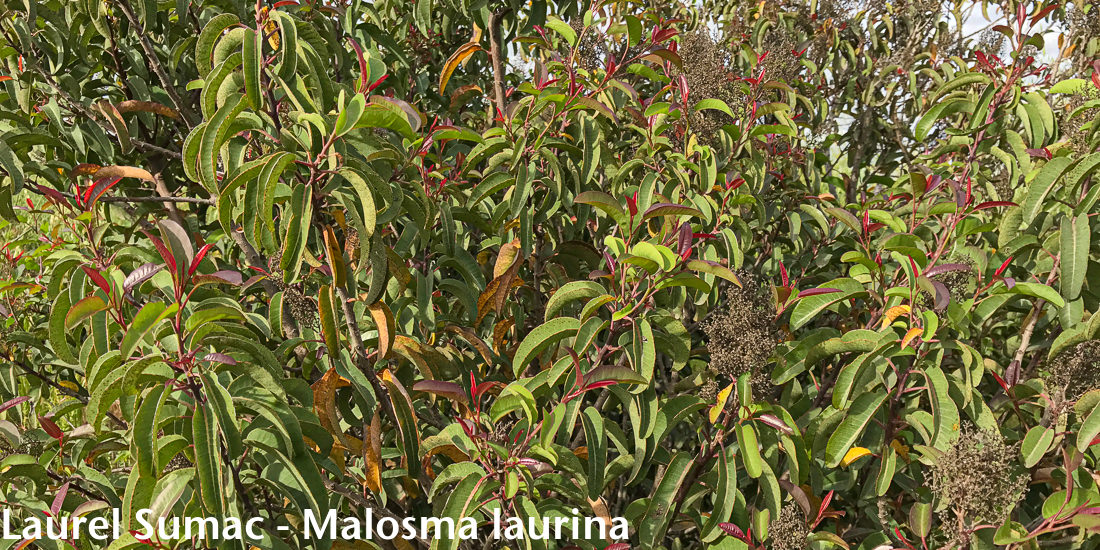
Yucca -
Hesperoyucca whipplei
Native, perennial, herb. Common plant in open chaparral areas. Yucca blooms from April to July, usually below 2000' but sometimes up to 8000' in elevation. Flowers are usually creamy-white, but east of the Santa Monicas it is said they can be a dramatic dark purple or pale pink. Some Yucca plants are considered monocarpic - growing from seed, flowering once in a 4 to 7 year lifespan before dying. Most of our plants produce offshoots from the base, creating a cluster of clones that continue to grow and reproduce. This form of Yucca when mature can then spread via 2 to 6 foot long rhizomes. Interesting fact - Yucca is a member of the Asparagus family.

Deerweed -
Acmispon glaber
Native,perennial,shrub. This common shrub can be found blooming nearly year-round. Its small yellow-to-red pea-shaped flowers appear in clusters spread out along its many branches. Flowers and leaves are both only about 1/4 to 3/8 inch long. The oblong leaves appear in leaflets of 3, also spread throughout along the stems. In the spring these plants have freshly-green colored leaves, yellow flowers and softer stems. The heat and dryness of summer cause the flowers to redden and the leaves to fall off; however the plant still has hardy growth because photosynthesis carries on in force in the stems. The base of the plant is somewhat woody, and trail maintenance workers needing to clear brush may find that pulling this plant out by the root works more effectively than trying to chop through the tangled mess of wiry branches.
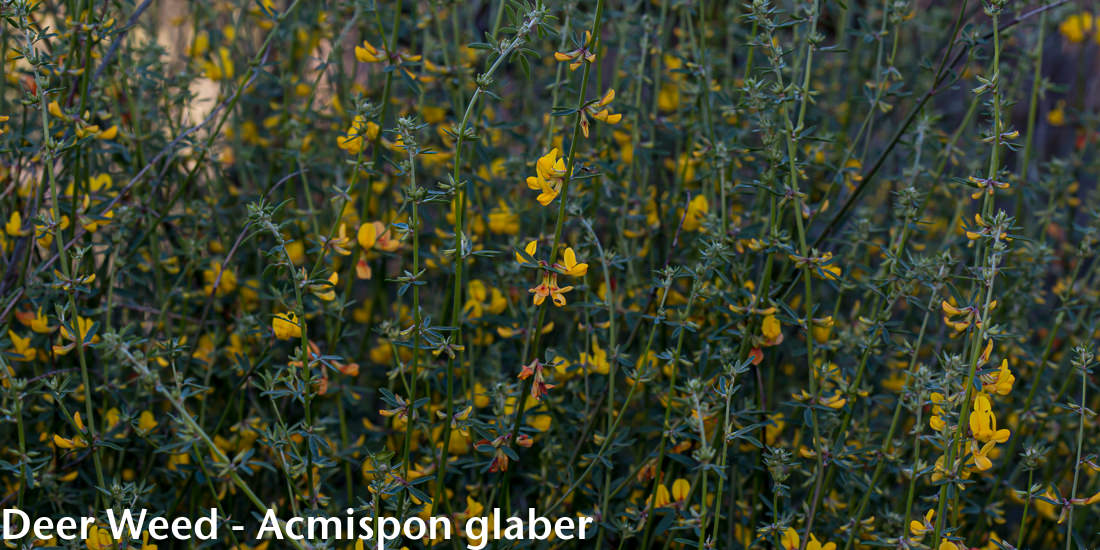
Lemonade Berry -
Rhus integrifolia
Native, perennial, shrub/tree. This plant has small flowers with five petals and five sepals clustered at the ends of the stems. The flowers of lemonade berry are white to pink. The fruits are red, hairy, and sticky. It commonly blooms from February to April. Sugar Bush, Laurel Sumac and Lemonade Berry are three similar looking plants you will encounter on many of your visits to the Santa Monica Mountains. Lemonade Berry seems to prefer the North side of the mountains, Sugar Bush prefers the Southern side and Laurel Sumac is not as choosy. Laurel Sumac leaves are longer and less wide. Lemonade Berry is rounder and shorter, Sugar Bush is somewhere in the middle. Too make things more interesting - Sugar Bush and Lemonade Berry are known to hybridize! What separates the Lemonade Berry is the fruits. The fruits are similar in size to a pomegranite seed and look nothing like either Sugar Bush or Laurel Sumac.
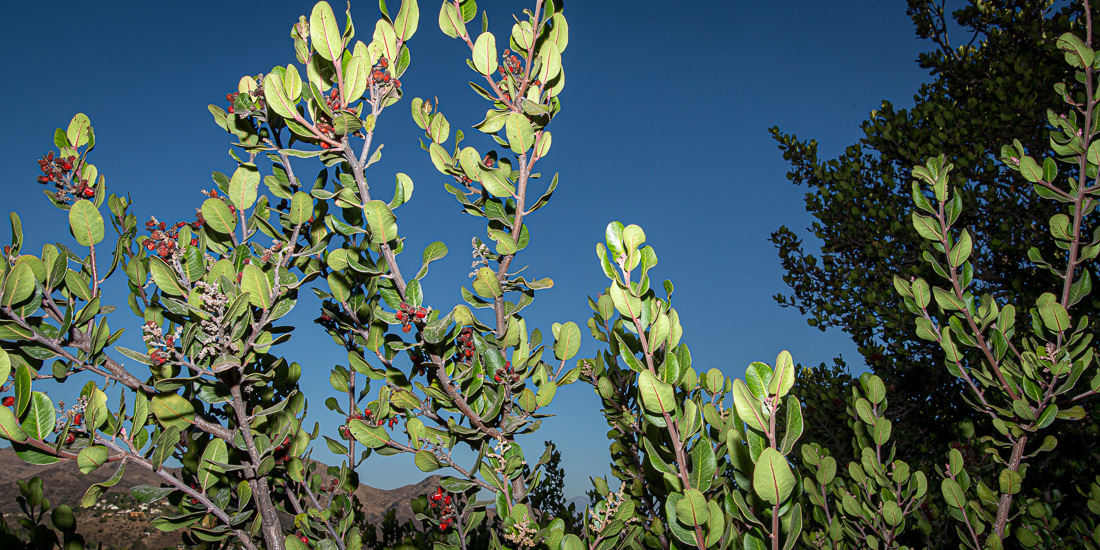
Holly Leaf Red Berry -
Rhamnus Ilcifolia
Hollyleaf redberry (Rhamnus ilicifolia) is a native shrub that grows in the foothills and mountains of southern California at elevations from 500 - 6600 feet. It was formerly considered a subspecies of Rhamnus crocea (spiny leaf red berry) but is now considered a separate species. This shrub ranges from four to 13 feet tall. This plant is common alongside many trails and your ability to identify it shows that you are becoming more skilled observing our native plants! This shrub requires looking at the leaves, flowers and fruits before making an identification. Look for evergreen leaves with small fine teeth and a somewhat oval shape. Densely branched plants provide cover and food for a variety of wildlife. Lots of tiny flowers and small red berries make this plant a favorite of pollinators, birds and wood rats.
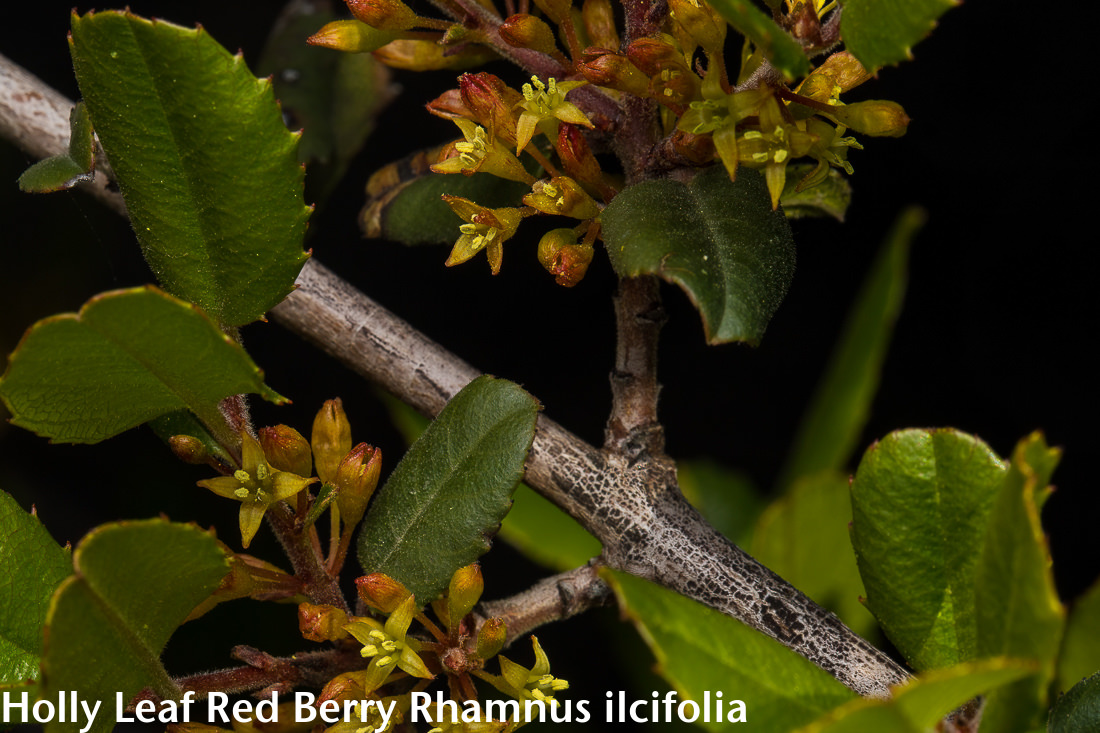
Wishbone Bush -
Mirabilis laevis
Native, perennial, herb. Wishbone Bush is a plant with a low-growing, many-branched, matted appearance. Its magenta flowers can be found blooming from December to June. It gets its common name from the appearance of its stems, which fork and resemble poultry wishbones. This is especially evident later in the warm season when leaves have fallen off and the plant is going dormant.
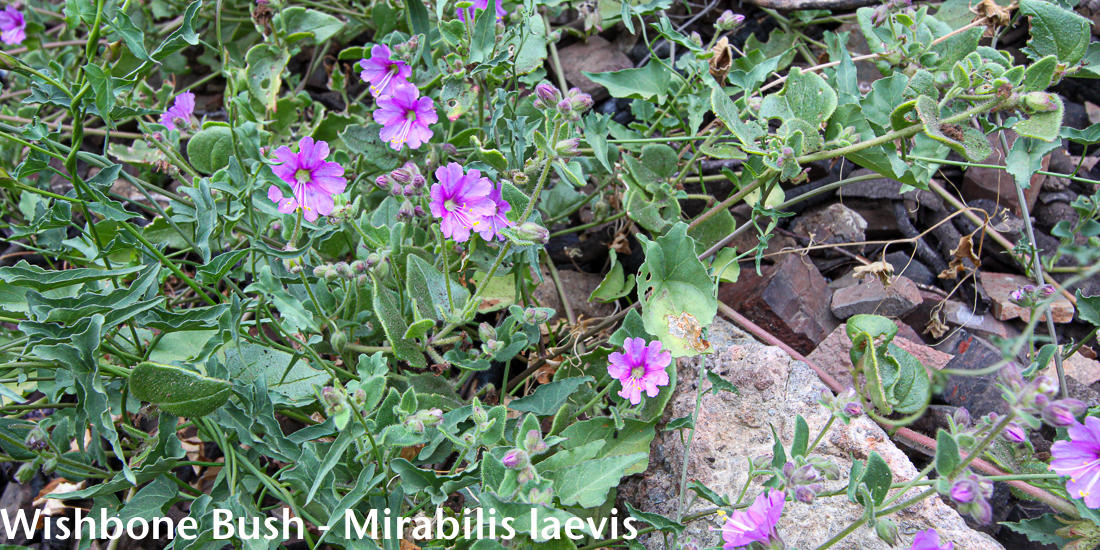
Chamise -
Adenostoma fasciculatum
Native, perennial, shrub. Chamise is one of the key members of the Chaparral plant community and also important for its fire-survival strategies. It is most abundant on south-facing slopes where many other plants cannot survive, where it thrives because it is well adapted. Chamise has a strong basal burl and peeling, reddish brown bark. The short needle-like leaf clusters/bundles on this plant conserve moisture and remain green throughout the summer - they are evergreen. Look carefully and note that the clusters alternate on the branches. Leaves are hard, thick and leathery to limit loss of water thru evaporation. Clusters of white flowers appear along the ends of branches, each flower about 1/4 inch or less in diameter. The flowers bloom from April to June before giving way to brown seed vessels.
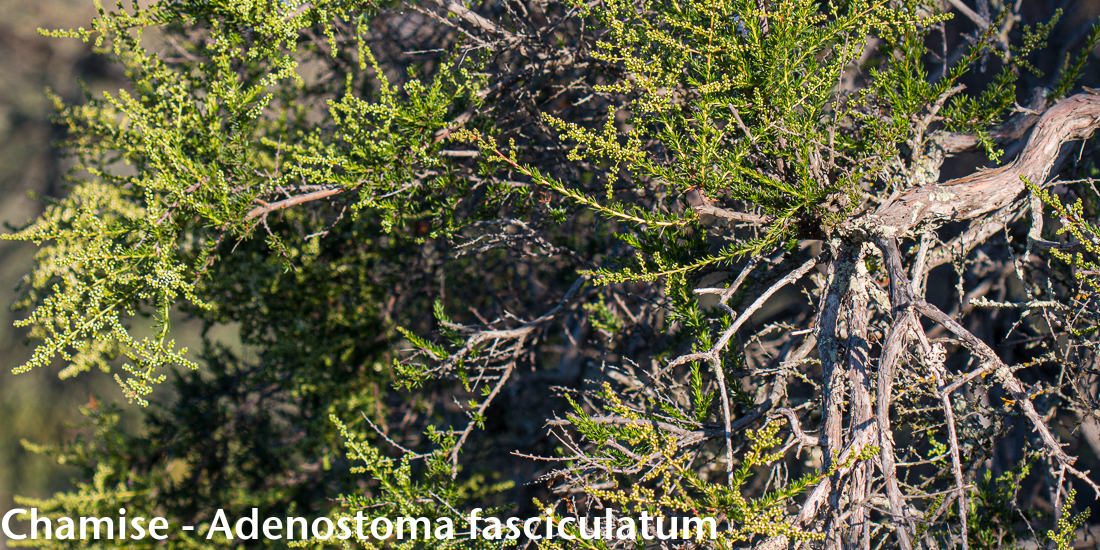
California Buckwheat -
Eriogonum fasciculatum
Native, perennial,shrub. California buckwheat is a ubiquitous member of the plant community known as the California chaparral. This low, evergreen shrub is seen covering our hillsides in its pale blooms for roughly half the year. White to pale pink flowers develop in walnut-size balls at the ends of branching stems from April to November; once bloomed they remain on the plant in a drier, browner state. Often the flower heads cover the plant such that one barely notices the foliage, which bears a resemblance to chamise. Evergreen, narrow, leathery leaves, less than an inch long, are gathered in bunches along the stems which are up to 5 feet long. The species name fasciculatum means "bundles".

Fringed Indian Pink -
Silene laciniata
Native, perennial, herb. This plant is more red than pink but definitely fringy. The flowers have five petals that appear slashed into fringes - Laciniata means "torn" - about an inch or so in diameter. It blooms from April to July. The leaves are linear-shaped, about 2 inches long. Leaves and the swaying, limp stems are hairy and sticky, making it one of several plants with the common name of "Catchfly". The genus name of Silene also refers to the excretion of a sticky or foamy substance - either for the intoxicated foster father of the Greek figure Bacchus, or the Greek word "sialon" meaning saliva.
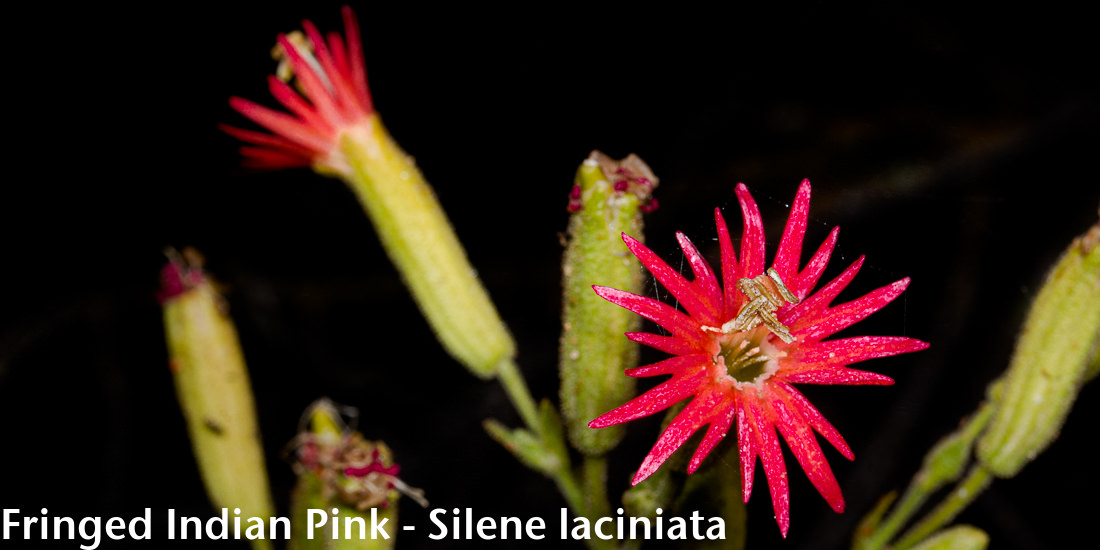
Bush Sunflower -
Encelia californica
Native, perennial, shrub. Bright, showy yellow blooms of Bush Sunflower can be found dotting hillsides from February to June. This fairly common plant takes the shape of a much-branched shrub, with hairy grayish-green stems supporting alternating lance-shaped leaves 1 to 3 inches long. The solitary flowers are found at the ends of long stalks. The central disk of the flower is a brownish color (sometimes with yellow) and is up to an inch in diameter. Striking yellow ray florets extend from the brownish center, their lengths commonly a bit longer than the diameter of the disk.
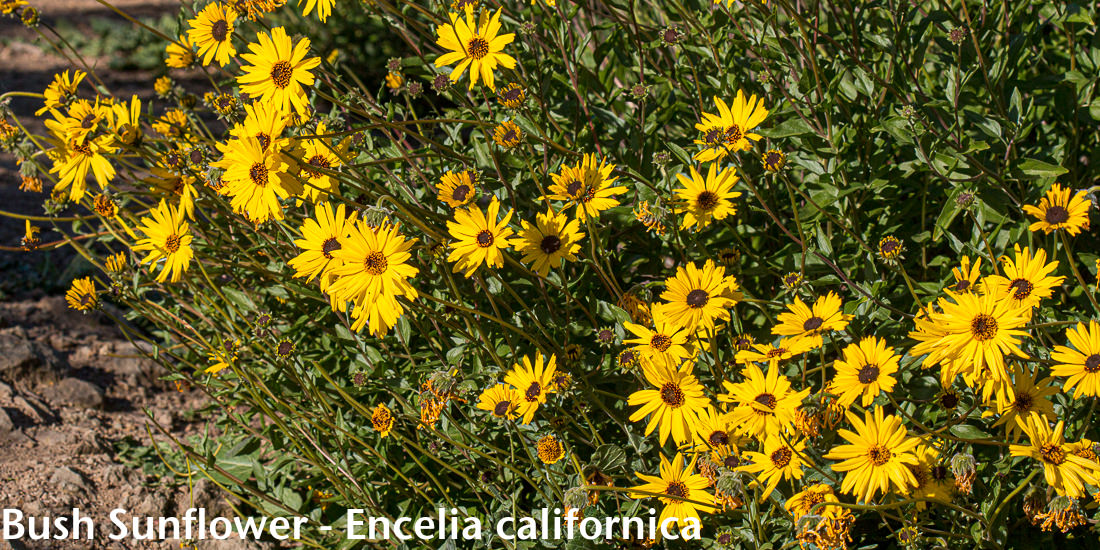
Sacapellote -
Acourtia microcephala
Native, perennial, herb. The small flowers on this perennial herb are found in hues from rose to purple and on rare occasion white.
The technical term for the flowers is bilabiate, discoid flower heads. This translates to a flower with an upper and lower segment (the upper is 2 joined petals while the lower segment has 3 joined petals) with the flowers having a regular, tubular corolla (like a bell). Snapdragons and Monkey Flowers are also bilabiate. The petals are about 3/8 inch long. The petals seem to alternate with white bristles (referred to as Pappus). The flower bud appears as striped white and chocolate-brown in color. When the the plant blooms you will see splashes of red, yellow, orange and white on the styles and beautiful white anthers. The white Pappus reminds me of shaving brushes. The petals are discarded when the seeds are ready for dispersal - this leaves the white Pappus shifting in the breeze until the wind carries the seed off. This plant blooms well after the first flowers of Spring. The leaves of this plant are alternating on the stem and are between four and eight inches in length. One interesting fact about the leaves is the way they connect to the stem - look for a heart shaped clasp where they connect to the stem.
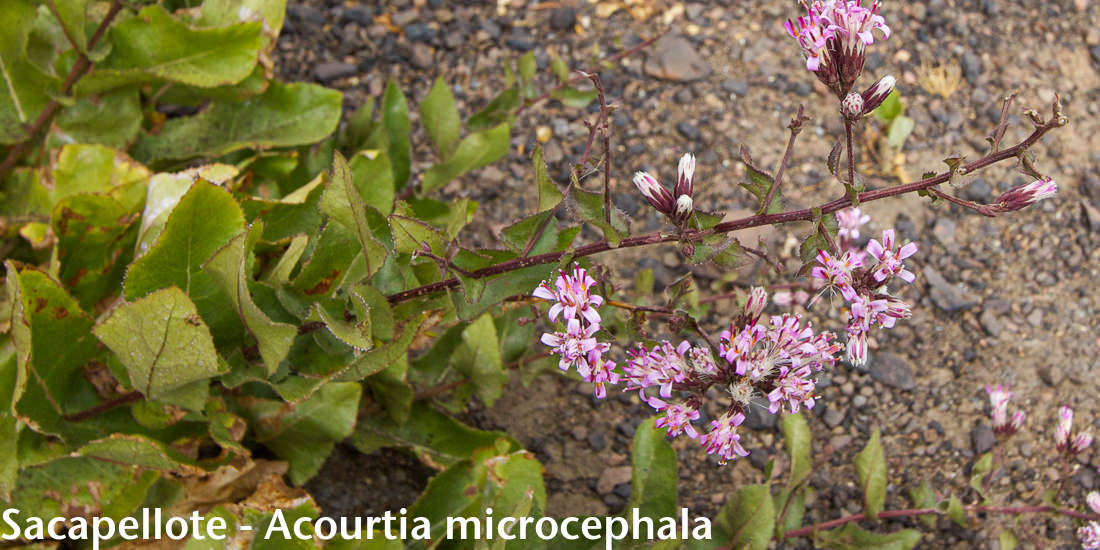
Sawtooth Goldenbush - Hazardia squarrosa
Native, perennial, shrub. This plant in the Sunflower family, blooms in the Summer/Fall. Tiny yellow flowers that resemble flowering pine cones and sharply pointed, holly-like leaves. As a late summer bloomer it provides an important nectar source for pollinators. Sawtooth goldenbush can take different forms: upright or spreading, a multi-branched sub-shrub. Typically, less than three feet (1 m) high. - leaves are opposite. Look for outer branches covered with loose white hairs and branching at sharp angles. The leaves are small and oval, thick and leathery, clasping the stem directly. Leaves are generally less than 1.5 inches ( 4 cm) long with sharp teeth on the margins. Leaf is smoother on top and the bottom may have white hairs lots of white hairs.
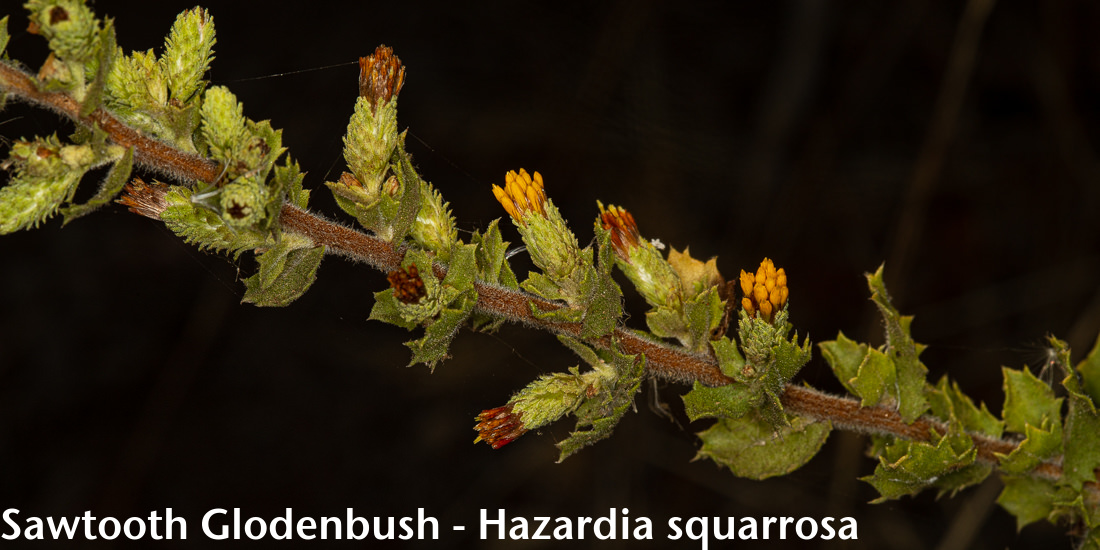
Rattlesnake Weed - Euphorbia albomarginata
Native, perennial, herb. Blooms nearly year-round (but commonly April to November) and is prostrate, meaning it grows flat on the ground. This probably allows it to access moisture in the form of dew and thus remain green well into the dry fall months of the Southern California climate. The plant forms spherical mats on the ground with many-branching stems. The tiny leaves, no more than a quarter-inch long, form at the end of short stems are heart-shaped or oblong, sometimes with white or red edges. The flowers are solitary from leaf axils, cup-like, maroon at the base with white petal-like margins or bracts (these are not true petals). Inside the cup, a single female pistillate flower is accompanied by up to 30 male staminate flowers. Typical of other members of the Euphorbia family, it has a white milky sap, known to be poisonous.
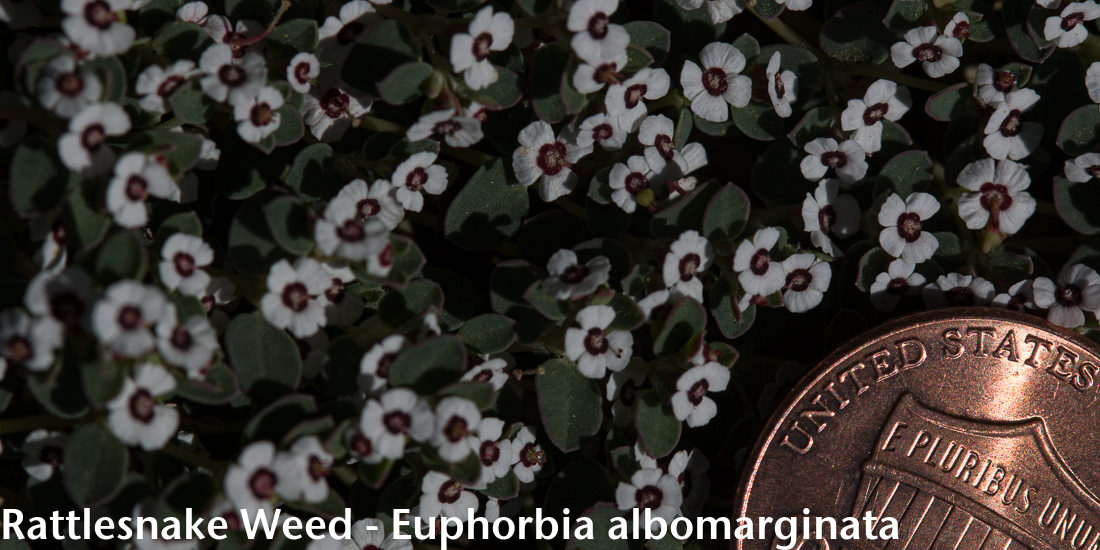
Toyon - Heteromeles arbutifolia
Native, perennial, shrub/tree. Toyon is most notable when the days shorten and weather turns colder. The small, bright red berries add a splash of color to the slopes of our local mountains this time of year. It is said that Hollywood got its name due to this plant's resemblance to holly. Toyon's thick, waxy and oblong leaves are 2-4 inches long with pointed teeth that spiral alternately up the plant's stems. The waxy coating of the leaves reduce the amount of water lost through transpiration (evaporation of water from plant leaves) and allow the plant to remain evergreen. Small, white perfect flowers (both stamen and pistil are present) containing five petals and ten stamens appear in summer and are pollinated by bees. The flowers are similar in appearance to Roses (they are a member of the Rose family). In late fall, these are replaced by pea-sized bright red berries, or pomes. These traits are shared by other plants in this wide and diverse family: apples, peaches, strawberries, plums and pyracantha.
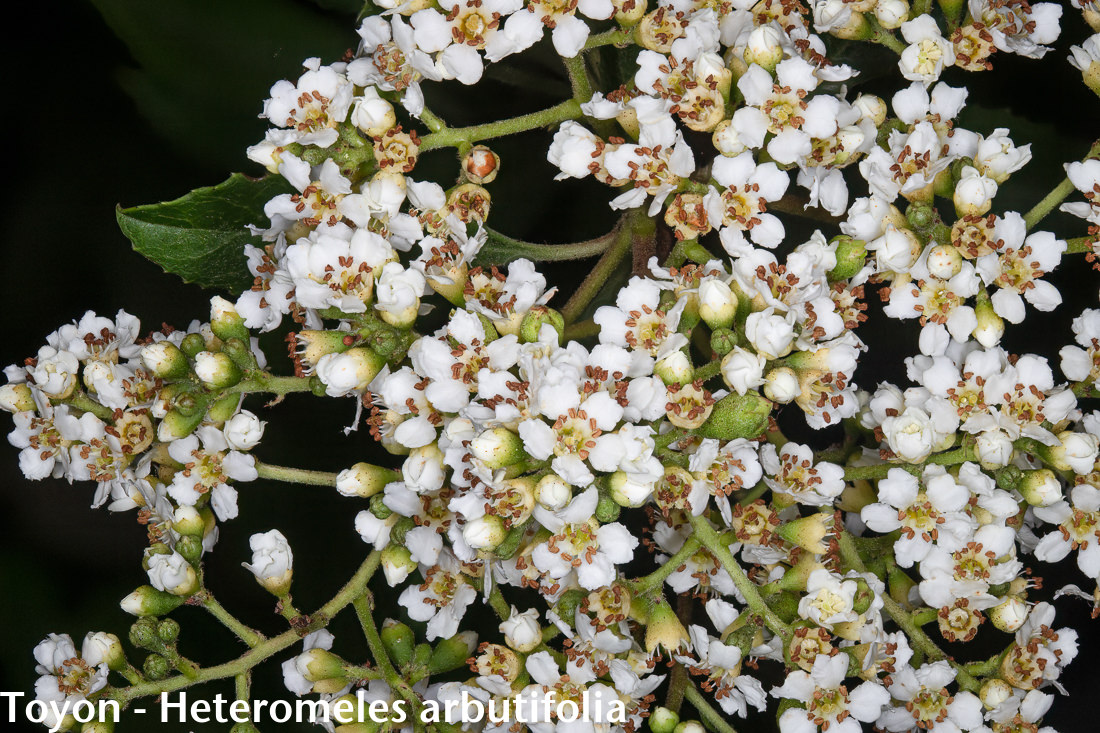
Plummers Mariposa Lily -
Calochortus plummerae
Native,perennial,herb. Pale yellow interior to pink edges, speckled appearance, usually fringed with hair near the base. May-July; 1 to 2 feet high, found in openings in chaparral and on dry, rocky slopes. Mariposa means "butterfly" in Spanish, and the flowers of this plant do bear some resemblance to the winged insect. They are are a few inches in diameter and quite showy, having 3 wedge-shaped petals and sepals, forming a goblet- or bowl-shape. Calochortus means beautiful grass, referring to the long, grasslike leaves, which are not very noticeable and wither somewhat when the plant is blooming.
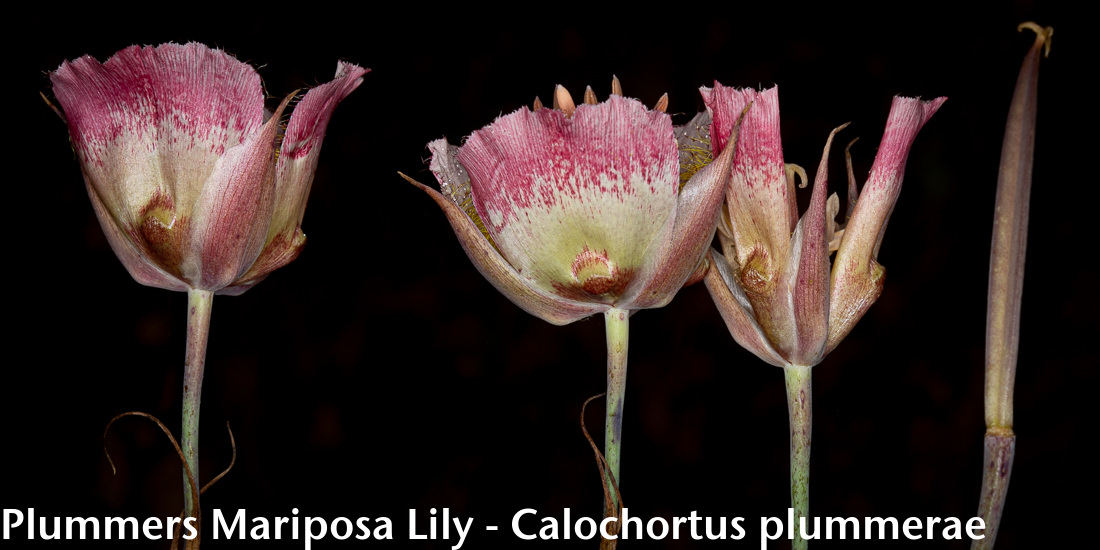
Twining Snapdragon -
Antirrhinum kelloggii
Native, annual, herb. Twining snapdragon is a vine-like plant that often clings to other plants or dry brush for support. It is often hard to spot due to its size, but when you do come across it you will know it. Its distinctive snapdragon-shaped flowers appear from February to May and are usually lavender to purple, but can also have varying shades of blue or white. The rest of the plant is very slender, with a central stem supporting several arching branchlets, each near a slender leaf up to a few inches in length. A flower appears 2 to 4 inches down each of these hairlike stems and is about 1/2 inch in diameter. The stems are frequently a reddish green color. The base of the plant is a bit more filled out but otherwise similar in appearance.
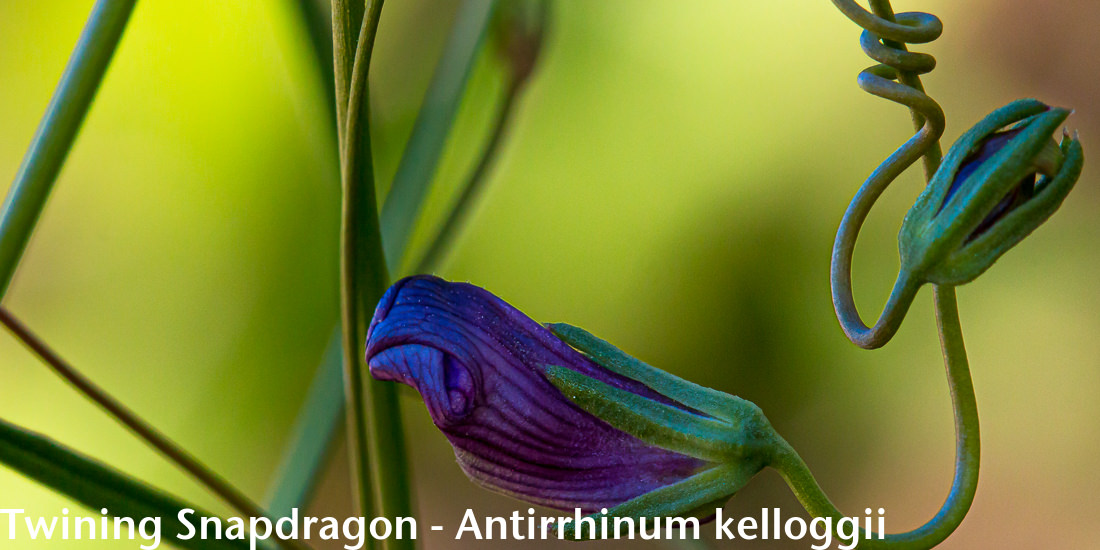
California Everlasting -
Pseudognaphalium californicum
Native,perennial,herb. A flower you are likely to see at the edge of the trail when moving through areas classified as sage scrub. During the heat of summer a delightful scent is released from the drying leaves. Some say it smells like maple syrup. This is one plant you can introduce to others and it is likely that they will remember it because of that aroma. The plant can be annual, biennial or a short lived perennial depending on local conditions. California Everlasting will become dormant during the summer and wait for the next rains to perk up its above ground appearance. This plant has composite flowers - what appears to be one flower is in actuality a cluster of many smaller flowers.
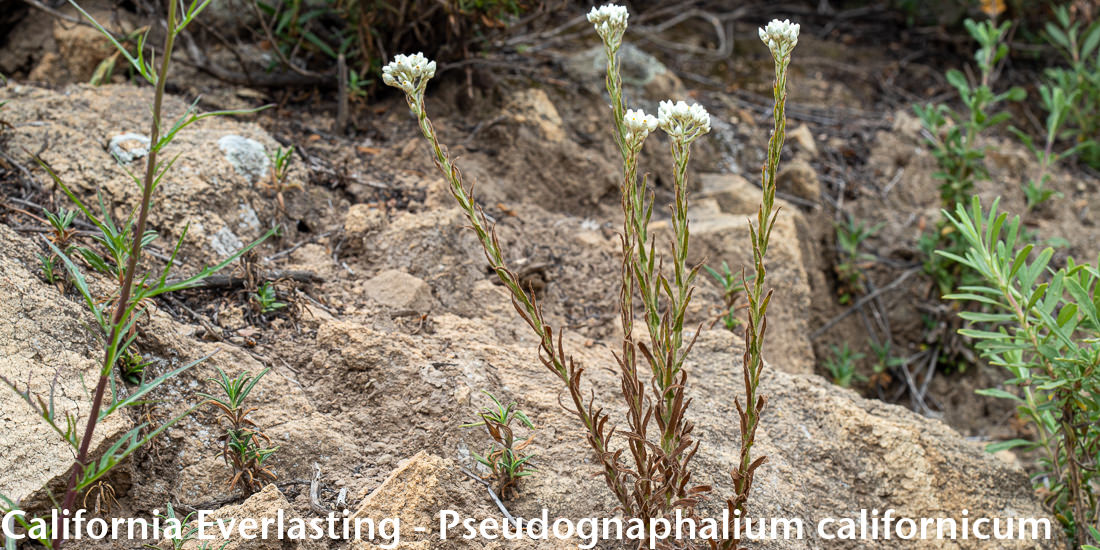
Primrose Mustard -
Eulobus californicus
Native, annual,herb. A lanky plant with sunny yellow flowers. Its shape resembles the common mustard weed. This flower is a magnet for White Line Sphinx Moth caterpillars. In the Spring, keep an eye out for these voracious caterpillars as they feast on their favorite plant. On the fire road leading into Upper Sycamore I have seen thousands of them! After undergoing metamorphosis, these caterpillars become the White Line Sphinx moth which maneuver from plant to plant like a hummingbird. The bright yellow flowers have 4 petals arranged in a whorl and about 1/2 to 1 inch in diameter. Solitary and not numerous, the flowers form on short stems in leaf axils. Sometimes there are red spots at the petals' base. Before flowering there is a grouping of larger leaves at the base of the plant, each about 6 inches long and lance-shaped. Leaves along the stem are shorter, narrower, fewer, and with jagged edges.
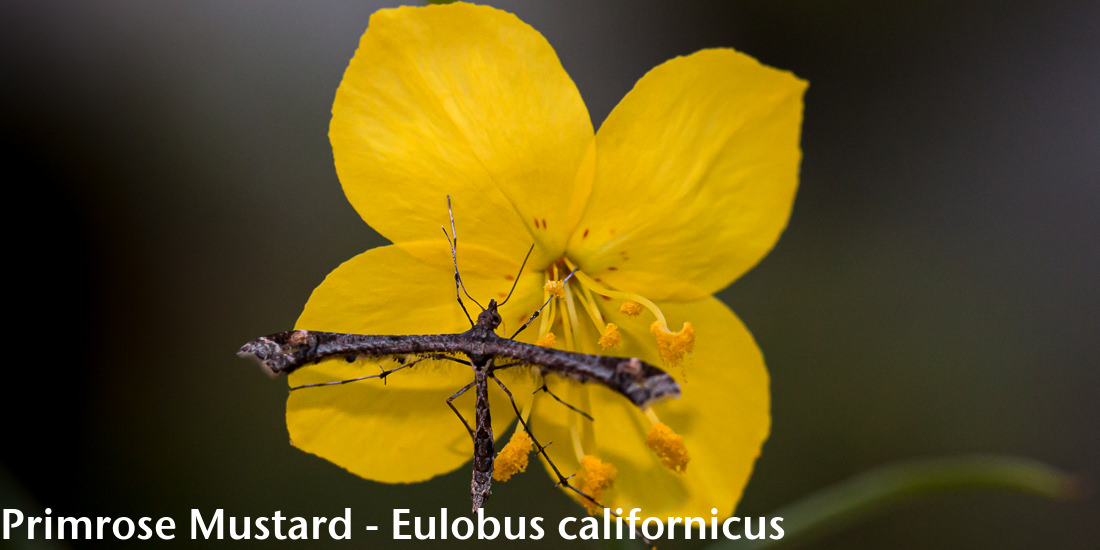
Parry’s Phacelia -
Phacelia parryi
Native, annual, herb. The deep purple color of Parry's Phacelia makes this plant easy to spot in springtime. It blooms from March to May and is often found in bare or disturbed ground, usually on slopes. If an area has burned recently, Parry's Phacelia is frequently found there. The velvety-looking flowers are 1/2 to 1 inch in diameter, with 5 petals in a pinwheel arrangement. 5 white stamens protrude from the flower's light-to-white center. Leaves are up to 2 inches long, gray-green in color, deeply veined, somewhat oval with jagged edges. The stems and branches are sticky and covered with hairs. Usually there is a solitary stem and the plant stands alone; other times there are small groupings of several plants growing together.
